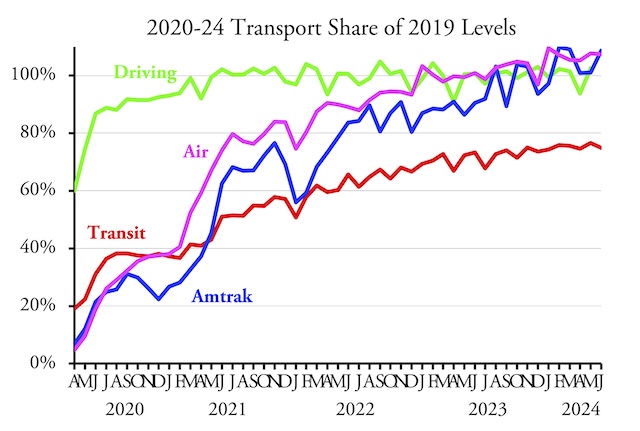Amtrak carried 654 million passenger-miles in June of 2024, an 8.6 percent increase over the same month in 2019, according to the state-owned company’s monthly performance report issued last Friday. Amtrak passenger-miles have been ahead of pre-pandemic numbers for every month since February 2024.
See last week’s post for transit results. Data are not yet available for driving but will be posted here as soon as they are.
Last week, I noted that the Transportation Security Administration counted 7.4 percent more airline passengers in June of 2024 than 2019. This number is not strictly comparable to the Amtrak number as this is passengers while the Amtrak number is in passenger-miles. The Bureau of Transportation Statistics keeps track of airline passenger-miles but releases the data nearly two months after Amtrak.
Amtrak reports that it carried 1.6 percent fewer riders in June 2024 than the same month in 2019. The increase in passenger-miles is because average trip lengths have grown by more than 10 percent, probably because people are preferring to drive on shorter trips that they previously might have taken by train. Air travel trip lengths have also grown since the pandemic, but by only about 1 percent.
Amtrak’s 2024 reports break down ridership and passenger-miles by individual route and by its three main groups of routes: the Northeast Corridor, state-supported day trains, and long-distance overnight trains. However, in 2019 it reported these breakdowns only by ridership, not passenger-miles. The data for June indicate that the Northeast Corridor carried 6.3 percent more riders than in 2019; state-supported trains carried 5.5 percent fewer riders; and long-distance trains carried 10.2 percent fewer riders.
While Amtrak seems to have fully recovered from the pandemic, it still carries an insignificant share of U.S. passenger travel. In 2023, the average American flew 2,300 miles, 137 times the 17.5 miles that the average American rode Amtrak. Other than speed, a major reason for this difference is cost: Amtrak fares averaged 39 cents per passenger-mile, nearly twice as much as airline fares, which averaged 20 cents.









Hopefully people will someday realize that that rail won’t work in the United States – it’s too big and spread out!
https://x.com/CompletedStreet/status/1823127642377224528/photo/1
The OPM pro-rail response will be, “More high-speed rail.”
(OPM=Other Peoples’ Money)
Rovingbroker, how do you think highways are funded?
Measured by benefit/cost ratio, highways are a success in public spending; HSR is an abject failure. Why don’t people get that?
janehavisham asked, “Rovingbroker, how do you think highways are funded?”
The Highway Trust Fund—the major source of federal road and bridge funding—is largely supported by gas taxes. This revenue is decreasing as fuel economy standards increase and more alternative fuel vehicles travel the roads.
A Federal Highway Administration program provides funding for states to pilot alternatives to gas tax revenues. Most states chose to test systems that charge for road use per mile driven. For example, California used its funding to test mileage-tracking technologies.
https://taxfoundation.org/research/all/federal/vehicle-miles-traveled-vmt-tax-transportation/
“The US has moved away from the user-pays model, primarily due to the gas tax
declining in real terms, but also due to excise taxes becoming weaker approximations of true user fees.
By 2034, the gas tax and other car-related excise taxes are projected to raise less than half of the Highway Trust Fund’s outlays”.
As long as highway users pay all the user taxes and transit users pay no transit user taxes and consume highway user taxes, the situation will be hopeless.
First, fix the diversions!
Jane Havisham wrote, “By 2034, the gas tax and other car-related excise taxes are projected to raise less than half of the Highway Trust Fund’s outlays.”
… because automobiles are becoming more efficient (using less gasoline per mile) and electric cars use no gasoline. But the same article spends most of its words with, “Highlight on Highways: Possibility of a Vehicle Miles Traveled (VMT) Tax.” … because there is no other obvious source of funds and technology has advanced over the decades since gasoline taxes were implemented. And because automobiles are incredibly useful and have no obvious substitute.